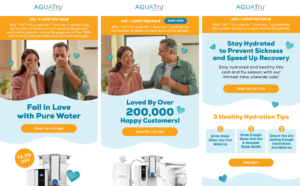Marketers are often heard talking about strategic planning. It’s the task all of us mean to get around to, but rarely ever do. So with the whole year stretching out before you, it’s time to ask yourself some tough questions about your goals and priorities for 2012 and formulate a strategy for the year ahead.
Analyzing your current activity will help you identify and prioritize opportunities to improve your email campaigns. And from this, your 2012 strategy is born. Producing a well-defined plan makes it easier to ensure your regular mailings are deployed on schedule, and allows you to allocate time for implementing exciting new campaigns to meet your strategic objectives.
Give yourself an email health check

The first stage in developing a plan is to audit your current activities, and clearly set down your new objectives. It’s probably crystal clear in your head, but does anyone else understand your vision? Begin by focusing on your campaign objectives for 2012. Consider primary as well as secondary objectives, and the tactics that will help you achieve them. The next task is perhaps the toughest. When every sinew in your body is telling you to look forwards and think about the future, what you really need to do is look backward and answer searching questions about past performance.
What did you do well last year? What worked and what didn’t? What were your biggest mistakes and regrets? Where were those missed opportunities?
Map out all the campaigns in your subscriber journey last year and for each mailing, make a note of the objectives the message was designed to meet. Consider your activity across all channels. Look at your triggered campaigns, plus service and marketing communications. Analyze your recurring mailings and focus on subject lines, creative, ‘from’ name, timing, and personalization and targeting.
Competitor analysis is also vital. How did you fare against your competitors? How well did your email campaigns stack up? And finally, where do you rank in your field? Are you market leaders, number 2 or bottom of the league?
Asking yourself these honest questions will help formulate effective strategies for the coming year. You must resist the temptation to mimic or follow your competitors, particularly if you are leaders in your field. Have an honest conversation with yourself! Once you’ve gathered and analyzed this information, it’s time to ask yourself some tough questions.
How well did you perform in 2011 against expectations? What went wrong and why? What went well and why?
This can be a painful process but one that’s also hugely rewarding. This is also the perfect time to set KPIs for the upcoming year.
Analysis of historic activity
You can add significant value to your 2012 plan by analyzing historic campaign performance. This means looking even further back, and your analysis should take in both recurring campaigns as well as your regular and ad-hoc mailings. It is worthwhile looking at each campaign’s overall performance as well as the specific types of content within each mailing. Including analysis of the timing of your mailings, such as day of the week or week of the month, will also help refine any testing required and ensure future campaigns are as effective as possible.
Campaign planning
The performance of each campaign, together with the objectives of your campaigns, will help focus your activities on the areas that present the biggest opportunities. This process will enable you to:
• Rationalize your current campaigns
• Highlight campaigns that would benefit from improvements
• Identify additional contact opportunities such as reactivation mailings, cross-sell, up-sell or a series of on-boarding mailings
You can then create an updated version of your subscriber journey, including any changes you plan to make throughout the year.
Testing can have a significant impact on the resources required to develop campaigns – particularly design, content and frequency-based tests. Be sure to include any upcoming testing in your plan so you can resource accordingly. A separate test plan may also be beneficial as it enables you to build over time on the things you’ve learned.
Content
Ensuring that each of your mailings contains content that is valuable to your subscribers can be one of the most challenging aspects of developing and optimizing campaigns. Yet it’s also one of the most important. Planning the content for your regular mailings will make it easier to generate new content. It may also identify opportunities to increase the frequency of interactions by serializing content and including teasers of upcoming content. Think about the customer journey for all your subscribers from new subscribers who have registered on your site, and new customers who opted in during their purchasing process, to regular customers and inactive subscribers. And be sure to include contact from all channels in order to get an accurate picture of what your subscribers will be experiencing.
Are you communicating everything your subscribers need to know? Are you missing any opportunities to strengthen your relationship with your subscribers? Or perhaps there is duplication that can be streamlined? Or any content that can be more cost effectively migrated online?
Seasonality and key events within your sector can also provide direction for content planning. It can also be very effective when used in conjunction with analysis of the types of content your subscribers have interacted with in the past. Your content plan doesn’t need to include the entire 2012 calendar – quarterly plans can be the most effective as they enable you to include more recent analysis, including the findings from any testing.
Finally, don’t forget to include subject lines in your plan. Your subject lines can have a significant impact on your campaign’s effectiveness, and by looking back you can easily identify what worked last year, and what didn’t for individual campaigns. The beauty of email is the ability to see which campaigns worked, and to back this up with hard facts. But don’t forget about non-openers! Your subject lines may be the only part of your communications that these subscribers see. Your subject line strategy should communicate your brand’s key values and build a story over time in order to maximize their effectiveness.





